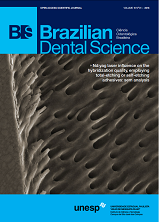Microbiological evaluation of dental stone casts after immersion in sodium hypochlorite and peracetic acid
DOI:
https://doi.org/10.14295/bds.2016.v19i1.1242Resumo
Objective: the purpose of this study was to evaluate the efficacy of disinfection of type III dental stone by immersion in 1% sodium hypochlorite and 0.25% peracetic acid at different periods of time (1, 5 and 10 min). MaterialandMethods: silicon dies were previously infected with strains of Bacillus subtilis for 15 min. Then, type III gypsum stone (Herodent, Vigodent COLTÈNE SA, Rio de Janeiro, Brazil) was inserted into the cavities to obtain contaminated specimens. A sterile silicone die was used to obtain uncontaminated specimens. The specimens were separated into positive and negative control groups, and further divided into the following groups: blocks immersed in sterile physiologic solution for 1, 5 or 10 min; blocks immersed in 1% sodium hypochlorite for 1, 5 or 10 min; and blocks immersed in 0.25% peracetic acid for 1, 5 or 10 min. All the groups were double-plated and incubated at 37 ?C for 24 h. Results: the results were expressed in colony forming units (CFU/ml) and the data were submitted to the Kruskal-Wallis test followed by Dunn’s test. The results showed that immersion in 1% sodium hypochlorite and 0.25% peracetic acid resulted in complete disinfection of the test specimens at all test periods (p < 0.01), whereas immersion in saline did not provide effective disinfection. Conclusion: it can be concluded that both 1% sodium hypochlorite and 0.25% peracetic acid provided effective disinfection in dental stone specimens immersed in the solutions described above, at different periods of time.
Keywords
Disinfection; Peracetic acid; Sodium hypochlorite; Stone casts.
Downloads
Downloads
Publicado
Como Citar
Edição
Seção
Licença
TRANSFERÊNCIA DE DIREITOS AUTORAIS E DECLARAÇÃO DE RESPONSABILIDADE
Toda a propriedade de direitos autorais do artigo "____________________________________________________________________" é transferido do autor(es) para a CIÊNCIA ODONTOLÓGICA BRASILEIRA, no caso do trabalho ser publicado. O artigo não foi publicado em outro lugar e não foi submetido simultaneamente para publicação em outra revista.
Vimos por meio deste, atestar que trabalho é original e não apresenta dados manipulados, fraude ou plágio. Fizemos contribuição científica significativa para o estudo e estamos cientes dos dados apresentados e de acordo com a versão final do artigo. Assumimos total responsabilidade pelos aspectos éticos do estudo.
Este texto deve ser impresso e assinado por todos os autores. A versão digitalizada deverá ser apresentada como arquivo suplementar durante o processo de submissão.




























